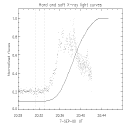
|
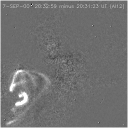
|
Introduction - sometimes it's hard to choose a topic
This week at least two newsworthy things happened. The first was a remarkable arcade event of September 5, which created a strong interplanetary shock and was almost homologous with the arcade of the Bastille Day flare of this year, which happened two solar rotations earlier. This illustrates the variabiilty of the relationship between CME eruptions and their counterparts in the low corona. We promise to deal with this item in a future science nugget.
Meanwhile, there is something hotter and nicer to be seen in a flare that occurred on September 7, which we introduce with the usual hard/soft X-ray plot to show the timing of the flare emissions (left below), and a difference image from the flare onset epoch (right below), which we think is remarkable:

|

|
This routine-looking flare already has done something interesting that the image above shows: loop brightenings, too faint to detectable yet by GOES (see the image times in the light-curve plot above), occur in several seemingly unconnected places. Of course we believe that the magnetic field in between these illuminated loops does connect them, but for some reason this field serves only to transmit energy and not to display it. The faint loops are not cool because SXT sees them clearly in its "hottest" X-ray analysis filter, a thick slab of Be (here "thick" means 0.119 mm). Furthermore, these unconnected, brightening loops are in motion - certainly expanding, and possibly some of them are contracting. Here's a short movie (two images only):
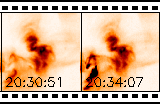
The impression of contraction can't be judged just from these two images, and it may be wishful thinking, but it would be consistent with the implosion conjecture as illustrated by a cartoon.
In any case, this early loop motion was not so fast, very roughly 100-200 km/s, but this flare did launch a Type II burst which typically implies rapid motion (although the Culgoora report only claimed a shock speed of 500 km/s, which hardly seems super-Alfvenic). And although we have not seen any reports, it is highly likely that this flare also produced a CME, based upon the ejective behavior we see in our intentionally overexposed (typically by more than two orders of magnitude)
The SXT images not deeply overexposed are, well, complicated but not very unusual. Here are four, from different phases of the event:
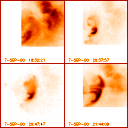
Note the wide dynamic range again - the non-flaring part of the active region is not changing in brightness and acts as a "standard candle" here. In the final image, an hour after the flare, we see the typical post-flare cusped arcade, which by now is considered rock-solid evidence that a CME had happened; note also the curious gap at the north end of the arcade. This reminds one of the amazing coronal X-point that appeared on the TRACE Picture of the Day Web page. At much higher resolution, of course, and in the quiet Sun rather than a post-flare loop system.
I don't have time to go into the main-phase outward flow detected in our deep images, but once again SXT seems to see a continued streaming along the opened field lines. Right now we have no idea where this mass winds up; it must be a part of the CME, but it is extremely hard to measure either the speed of the flow or its mass.
Comment: This lesson applies even more strongly to narrow-band imagers, such as TRACE and EIT, because they are more selective than SXT's broad spectral bands. The contention here is that the tracery of seemingly unconnected loops seen in the onset images guide us to something monstrous developing in the corona - to become a CME - and in the meanwhile the intense flare loop is gaining brightness, density, energy, pressure by a transport process involving the un-observed active magnetic field. Somehow!
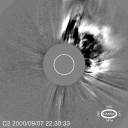
September 8, 2000